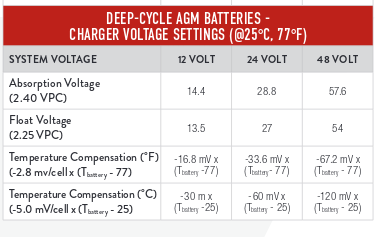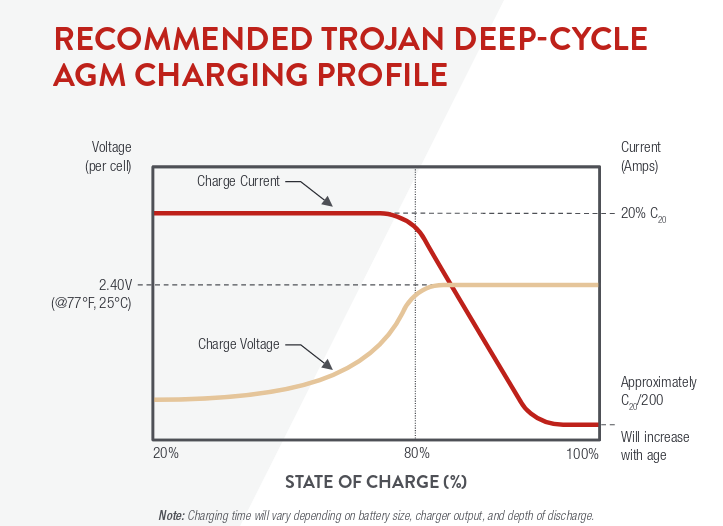Table of Contents
Solar charge controller setpoints
Solar charge controller, converter, and DC-DC charging behavior is guided by setpoints, which are settings stored in the controller. They may or may not be configurable by the user.
The two most important setpoints for battery life and performance are charging voltages: Absorption voltage and Float voltage, discussed below.
charging setpoints
Charging setpoints are configured in accordance with the battery manufacturer's recommendations.1) These recommendations are published in manuals, spec sheets, corporate blogs, etc. For example, Trojan's recommendations for charging their T-105 AGM batteries looks like this:
- Absorption voltage (Vabs) - the voltage the battery bank is held at until Absorption stage2) is completed. In this case the recommendation is 14.4v. Completed absorption means your lead batteries are fully charged.3)
- Float voltage (Vfloat) - the voltage the battery bank is held at during Float. In this case the recommendation is 13.5v.
- Equalization voltage (Vequal) - the voltage the battery bank is held at during Equalization. In this case the recommendation is 15v+.
- Temperature compensation - how the voltage setpoints are adjusted for temperature. While this is sometimes configurable, the compensation factor is close enough between manufacturers that it is often left at the default.
- endAmps - the amount of current (or percentage of capacity) accepted by the battery in late Absorption that indicates it's appropriate to Float. In the lower-right of this graph Trojan shows it as C/200:4) Also see absorption duration below.
Simpler charge controllers may only have preconfigured presets like “FLOODED” or “AGM” and don't let you set exact setpoints. If this is the case pick the closest preset to the recommendations5) and understand you will likely not get full performance or lifetime from the battery bank. Shunt controllers typically have only one configurable voltage setpoint. The simplest controllers may have no battery settings at all, and may or may not publish what those mystery settings are.
Less common setpoints:
- Absorption duration - the amount of time Vabs will be held until dropping to Vfloat. May be used instead of or in addition to any endAmps above. endAmps is more precise but can be tricky to measure, as loads or multiple controllers can obscure the true level of current being accepted by the battery.
- Absorption restart - voltage (or duration) at which Absorption stage after failing to maintain Vfloat. Sometimes called rebulk or reboost.
- Equalization duration - the amount of time the controller will hold Vequal.
- Equalization frequency - the number of days between equalization. 30 days is typical.
load setpoints
Only present on controllers with LOAD outputs.
- Low voltage disconnect (Vlvd) - voltage at which the controller turns off loads to prevent excessive battery discharge. Typically something like 12.1v (the voltage at 50% depth of discharge). Heavier loads that cause voltage sag may require setting a lower Vlvd so the voltage pops back up to 12.1v6) when the load is removed.
- Low voltage reconnect (Vlvr) - the setpoint at which the load is turned back on after recovering from Vlvd cutoff. Vlvr > Vlvd. If Vlvr is set too close to Vlvd the loads may continually toggle on/off.
non-setpoint settings
- Minimum charge rate: not stated in our example, but typical minimum charging values are ~C/10 for flooded lead batteries, and ~C/5 for AGM. Lithium does not have a practical minimum rate so is not damaged by weak charging.

